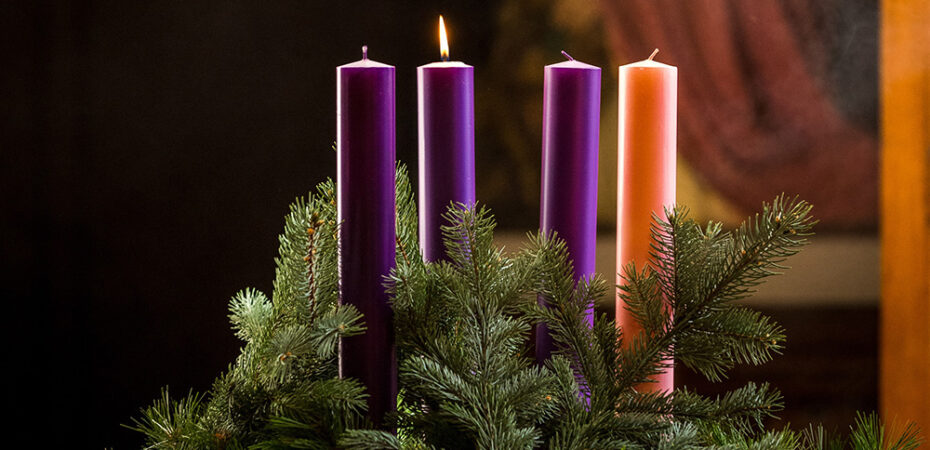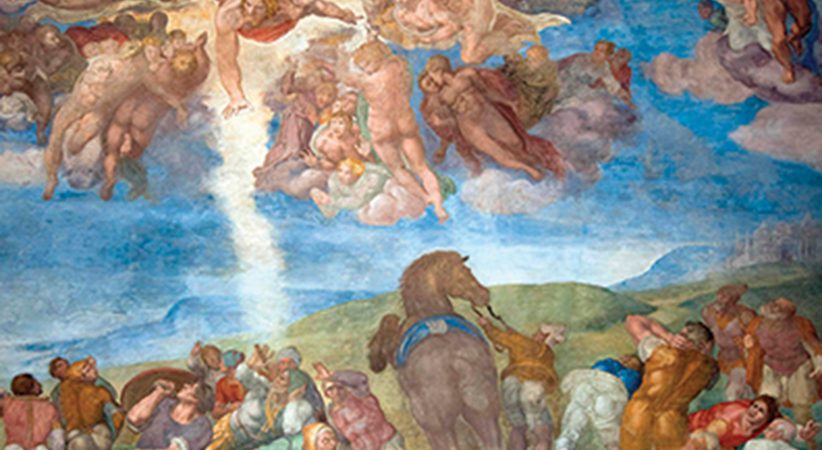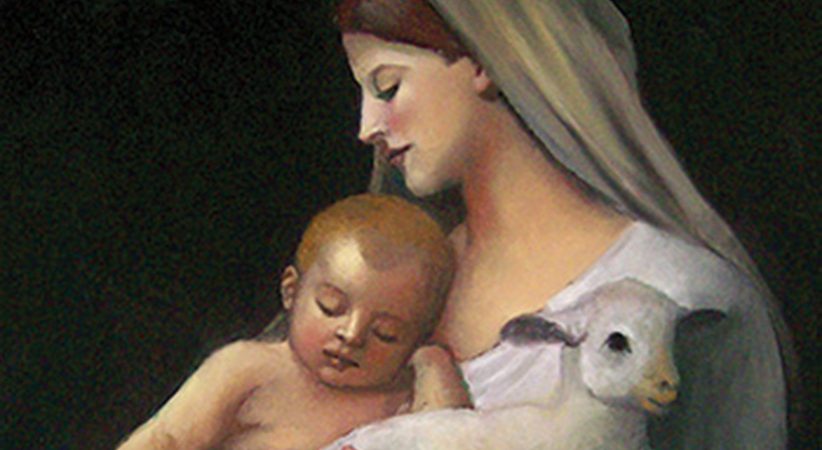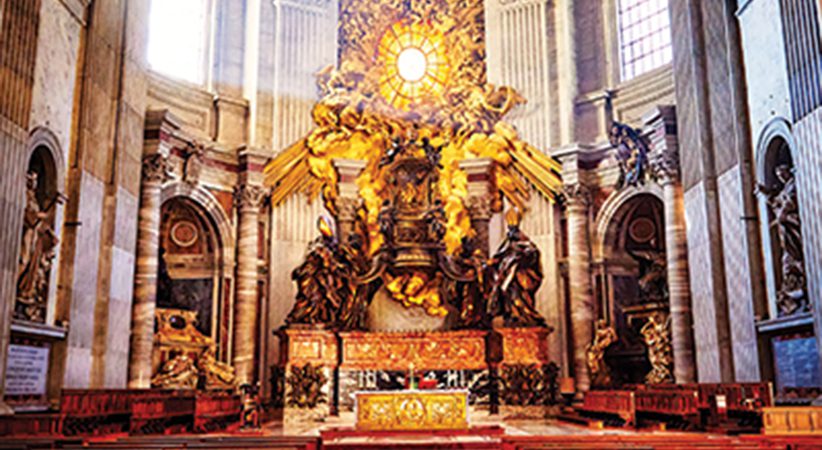The Advent Wreath
The candles call us to pray, do penance and do good works
D.D. Emmons Comments Off on The Advent Wreath
John the Baptist best describes this holy period we know as Advent by saying, “One mightier than I is coming” (Lk 3:16). We are called during Advent to get ready, to prepare ourselves for the birth of Our Lord, Jesus, at Christmas. It is a season of penance, expectation and hope. We wait and watch with Mary and Joseph, just as the shepherds and the Magi did all those centuries ago. Besides those few, the world didn’t have a clue that the Messiah was about to be born. But as we await the Incarnation, we do not lose sight of the fact that Advent is also about his second coming.
The wait associated with the days of Advent is made up of ever-increasing expectations followed by growing jubilation as the birth of the Savior draws near. It is meant to be a time of active preparation, of reconciliation, of properly disposing ourselves for the abundant grace we are about to receive. Thomas Merton wrote: “What is uncertain is not the coming of Christ but our own reception of him, our own response to him, our own readiness and capacity to go forth and meet him” (“Seasons of Celebration,” Farrar, Straus and Giroux).
In many parishes, helping us count down to Christmas day, the birth of Christ, and keeping us focused on this glorious mystery is the Advent wreath. The display of a wreath in a parish is not obligatory; it is not identified as a liturgical practice. Bishop Peter Elliot, in “Ceremonies of the Liturgical Year” (Ignatius Press, $21.95), writes, “In some churches it is customary to set up an ‘Advent Wreath’ in or near the Sanctuary … because this is an optional custom there is no official rite for lighting the candles. It is customary in some places for the wreath to be blessed on the First Sunday of Advent.” The history of the wreath is exciting and, of course, tied to Advent.
History of Advent/Wreath
The history of the Advent can be traced to the fourth or fifth centuries, a short time after the date of Christmas was established. Very quickly, Advent became to Christmas what Lent is to Easter. For centuries, Advent lasted 30-40 days and included obligatory days of fasting. It spread into the Roman Church by the sixth century, and in the ninth century the length of Advent was reduced to the four Sundays before Christmas. The Advent wreath didn’t surface as a seasonal custom until the 16th century, and then primarily in Germany. So, a season of Advent in preparation for Christmas has been long celebrated, but the Advent wreath is much more recent.
The use of a wreath to identify something or someone as special goes back to ancient Greece and Rome and even to other lands and cultures. Kings and queens sometimes wore wreaths to indicate their stature; many images of Caesar show him wearing a wreath. Victorious Roman generals were crowned with a wreath to signify triumph in battle. Our Lord was crowned with a wreath of thorns.
In Scandinavian and Germanic countries of ancient times, wreaths of evergreen boughs were often made in the darkest part of winter. The tree cut as a Christmas tree was pruned of many limbs and the remaining boughs were used to make wreaths and hang them on the tree or in homes. First, they were hung vertically, much like how we place a wreath on our front door during the holiday seasons. One of the earliest horizontal wreaths was made in Scandinavia (some say Germany) from a wagon wheel, around which 20 candles were placed.
The evergreen tree was most often picked because it survives even the harshest winter. And because of its evergreen nature, the people saw in the tree, wreath and candles a sign of hope, that the darkness of winter would eventually give way to the sunshine of springtime. Christians of the 19th century, especially in Germanic countries, brought the wreath into their homes as part of Advent, adorning it with four candles. During the 1930s, German immigrants introduced the Advent wreath into the United States.
Parish Displays
The Advent wreath appeared first in homes and then in the church, but exactly when it became popular in the Catholic Church is not easy to define, and It is not a universal custom. A blessing for the Advent wreath was not part of the USCCB Book of Blessings until 1989.
According to the Book of Blessings, the ceremonial blessing of an Advent wreath takes place on the First Sunday of Advent or the evening Mass before. In the Gospel reading for Cycle B of that First Sunday of Advent, which happens to be this year, we read: “But of that day or hour, no one knows, neither the angels in heaven, nor the Son, but only the Father. Be watchful! be alert!” (Mk 13:32-33). And, “May he not come suddenly and find you sleeping” (v. 36). These words of Jesus are meant to awaken us and put us on notice that he will return.
No ritual or ceremony is prescribed for the second through fourth Sundays; the lighting of the candles on those Sundays normally takes place outside the Mass and parish members are often selected to light the candles. These weekly candle lightings serve to call us away from the temptations and novelties so prominent in secular society this time of year and remind us to focus on readying ourselves for the day when Christ comes into our midst.
Makeup of the Wreath
While there is no particular guidance about Advent wreaths, the wreaths displayed in our churches are ideally made of fresh limbs from the evergreen tree (although artificial wreaths are not uncommon). The limbs are secured together and shaped into a circle, a sign of God’s endless love, of eternity. Some places add pine cones or holly leaves; the hollies, with their spiked or prickly tips, remind us of the wreath of thorns on our Savior’s head. Each of the four candles placed around the inside of the wreath represents a thousand years between the time God created Adam and Eve and the time of Christ’s birth. The candle colors are traditionally three violet and one rose, although white (purity) may be used. The violet or purple candles call us to pray, do penance and do good works as we await the birth, the coming of Christ. The flame is important, representing Christ shining through the darkness.
The rose candle is representative of the joy of the season. There is no Church-specified order of lighting the candles. They are typically lit so that one is added each Sunday with the one from the previous Sunday(s) lit first. The rose-colored candle is always lit on the Third Sunday of Advent — Gaudete Sunday. The rose candle indicates we are halfway through Advent. At Christmas, a white candle is often added to the wreath. The darkest time of the year is illuminated by the flames of the Advent wreath — the light of Christ.
There is no rule as to when to take down the Advent wreath display. Some parishes remove the wreath before the first Mass on Christmas Eve — Advent is over. Sometimes, parishes continue the display, keeping the added white candle at the center of the wreath burning during all the liturgies until the Church celebrates the baptism of Jesus and the Christmas season is ended. So, removal seems pretty much up to parish leadership.
D.D. EMMONS writes from Pennsylvania.
…………………………………………………………………………………………………………………………………………….
Advent Wreath in the Home
Displaying an Advent wreath in the home has long been a traditional and popular custom.
The Church’s Directory on Popular Piety and the Liturgy: Principles and Guidelines, from the Congregation for Divine Worship and the Discipline of the Sacraments, says: “Placing the four candles on green fronds has become a symbol of Advent in many Christian homes, especially in the Germanic countries and North America. The Advent wreath, with the progressive lighting of its four candles, Sunday after Sunday, until the solemnity of Christmas, is a recollection of the various stages of salvation history prior to Christ’s coming and a symbol of prophetic light gradually illuminating the long night prior to the rising of the sun of justice (cf. Mal 3:20; Lk 1:78)” (No. 98).
Guidance for blessing the Advent Wreath in a Catholic home is contained in “Catholic Household Blessings and Prayers” (U.S. Conference of Catholic Bishops, 2020).
……………………………………………………………………………………………………………………………………………….





